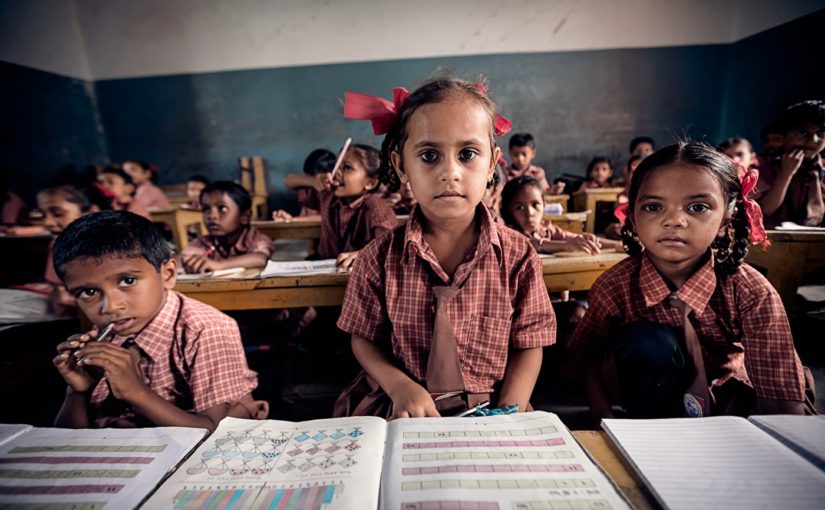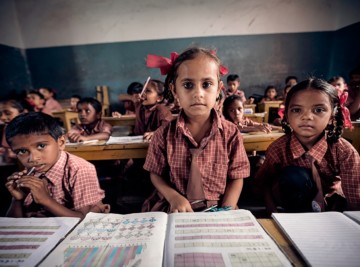Kids most affected by the fragile primary education system in India
School education has always been a problem for India in recent decades. India has definitely made significant progress in access to schooling and enrollment rates in primary education but dropout rates and quality in the education is still a big worry and now it is becoming a threat to central and state government.
The school enrollment in the primary (class I-V) section in India has been a matter of talk. There have been various programs and drives to increase the enrollment even in the tribal and remote areas. Enrollment is reaching to an approximate value of 96 percent since 2009 with the girl child enrollment soaring to 56 percent of new students between 2007-2013, it is clear that many problems for access to schooling have been addressed. But not the most. After the increment in the infrastructure, we have approximately 14 lakh schools and 77 lakh teachers. Although the number looks very high, if we see it in proportion of children in India it is not at all close to sufficient. Same is true for teachers also. The average number of teachers per school is 5.5 and this tells the whole story. The number 5.5 may looks good because it gives the impression that we have close to 5 teachers in every primary school but it is important to understand that it is the statistical way of understanding and not the actual figure, Mark twain once said about statistics “lie, damn lie and statistics”. There are plenty of schools which don’t have teachers or just one teacher and on the other hand there are schools which has more than 10 teachers. This inconsistency in distribution of number of teachers is one of the important reasons for not delivering the effective education at primary level — there are not enough teachers in our schools!
Surely government has done some work to increase the enrollment. The big question is, are parents sending their wards because of some exceptional work done by school in terms of education?
The answer is arguably “NO”. Leaving the exceptional case apart, in general the primary school system is collapsing. The mid day meal has served the purpose to mitigate malnutrition among children to a certain extent and it also helps in the enrollment of the new students. Apart from mid day meal other benefits also attract parents, like scholarship to all the students of reserved category, cycle, dress, etc. Many a times students get enrolled because of these benefits only. The local education department officials put teachers on work. They are told to go from home to home and convince parents to send kids to school to build up statistics to make them (their district) look better on the paper.
But despite all odds, definitely the improvement in enrollment is seen in the last decade. India is struggling to keep its school enrollment intact for the next level of primary education. The drop-out rates continue to be very high and is a matter of concern. Approximately 30 per cent of the children don’t finish their primary education and drop out before completing 5 years of their school system. Approximately 43 per cent of students drop out of their upper primary school education. Almost 58 per cent of the students drop out of their higher school education.
Approximately 14 lakh children between the age of 6 to 11 years old in India don’t attend school. This puts India within top five countries having out-of-school children in primary school age. Around 53 per cent of schools have functional girls toilets and close to 60 per cent have access to clean drinking water, and there are various other reasons which are responsible for this situation.
India desperately needs a uniform and effective long term education policy irrespective of government in the centre and state. The quality of learning is a major problem and this has been reported numerous times by various agencies. A report shows that children are not achieving class-appropriate learning levels. According to Pratham’s Annual Status of Education 2013 report, close to 78 percent of children in Standard III and about 50 percent of children in Standard V cannot yet read Standard II texts.
Pratham’s report, to a certain extent, confirms that there is a huge learning gap among the classes then certainly authority should think in the direction of changing the assessment methodology to suit the students according to their learning ability. They should not assess these children on CCE pattern and should develop new ways of assessment.
There is also a huge coordination gap between Anganwadi and school system. The mandate of Anganwadi is also to provide pre-primary education to children but our research found that most of the children when they reach primary section don’t know anything of pre-primary level and the learning gap starts at this point onwards. Promoting to the next class without proper assessment also leads to drop out.
Arithmetic is also a cause for concern as only 26 per cent students in Standard V can solve a division problem. Teaching methodology is a bigger problem and needs immediate attention. Teaching methodology needs to be overhauled and creative learning should take place instead of book learning. Overall Indian primary education needs immediate attention and help, so that children can effectively progress in our education system. Improving the quality of learning in schools is the next big challenge for the government.
To improve learning, many things need attention, like — uniform curriculum in the schools, making teachers more responsible and accountable, providing teachers with better infrastructure to work, increasing the attendance of teachers, focusing more on creative learning, consistency in policy and its effective implementation, better assessment methodology at each grade level and more efficient monitoring and support systems. Increasing the number of schools and teachers, bringing down the student – teacher ratio to 10 – 1, spending larger portion of the budget for education, creating an efficient regulating mechanism to keep a check on the private school system are few of the important points needed for our primary education system on urgent basis.
With inputs from Brookings.edu and Rajesh sahani
This article is a repost from The Truth One. Image by Sindhur Reddy.


